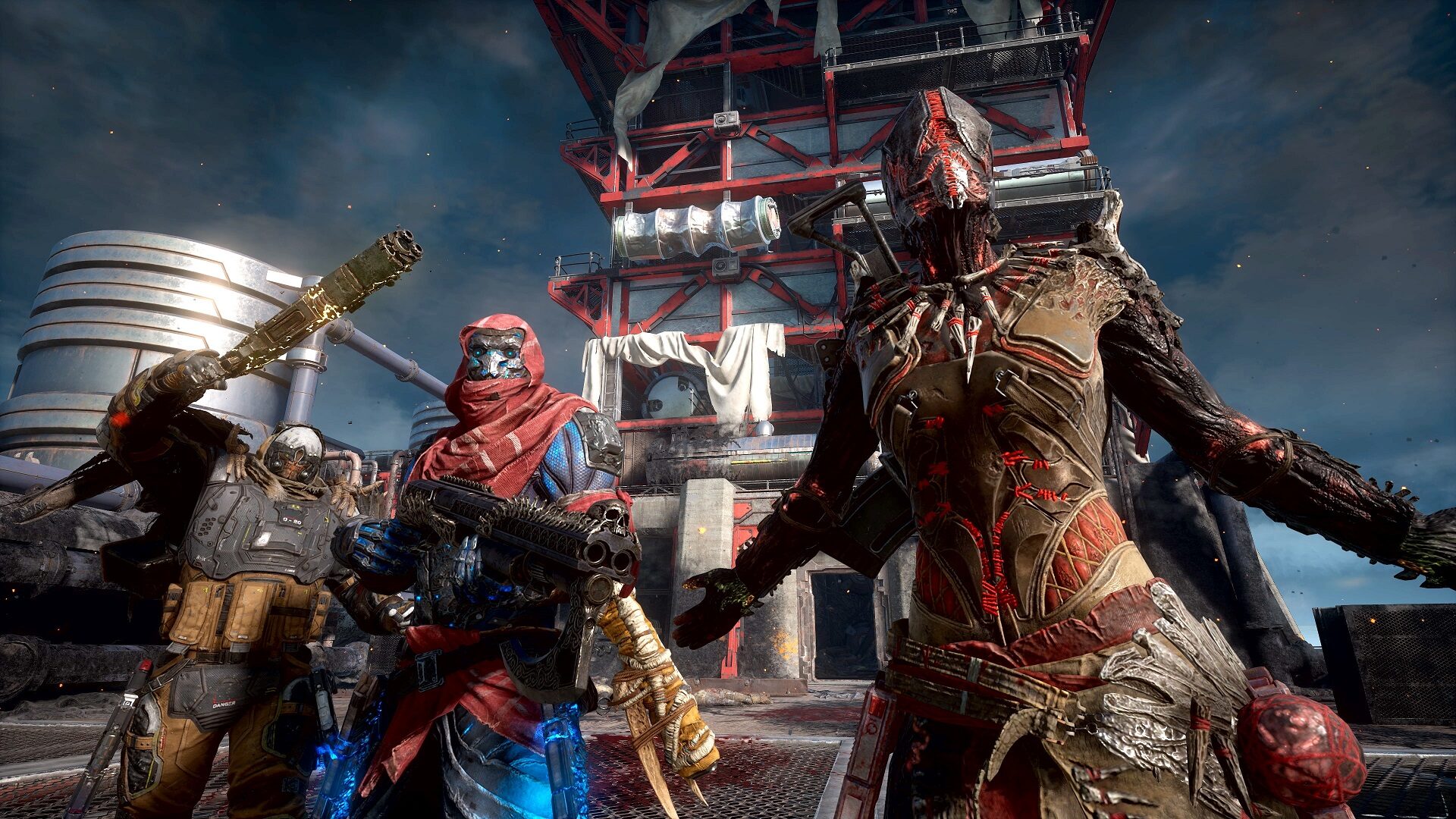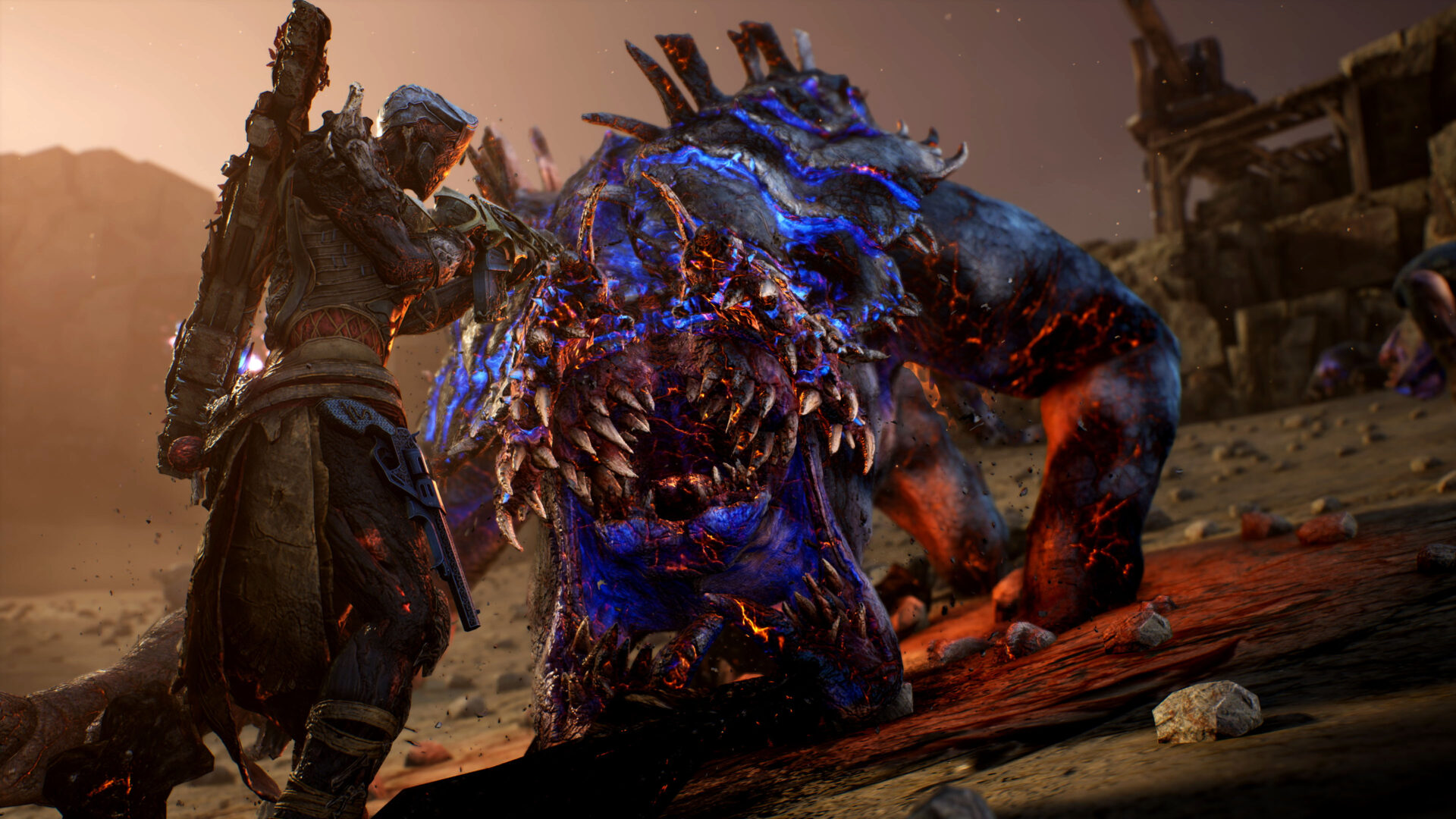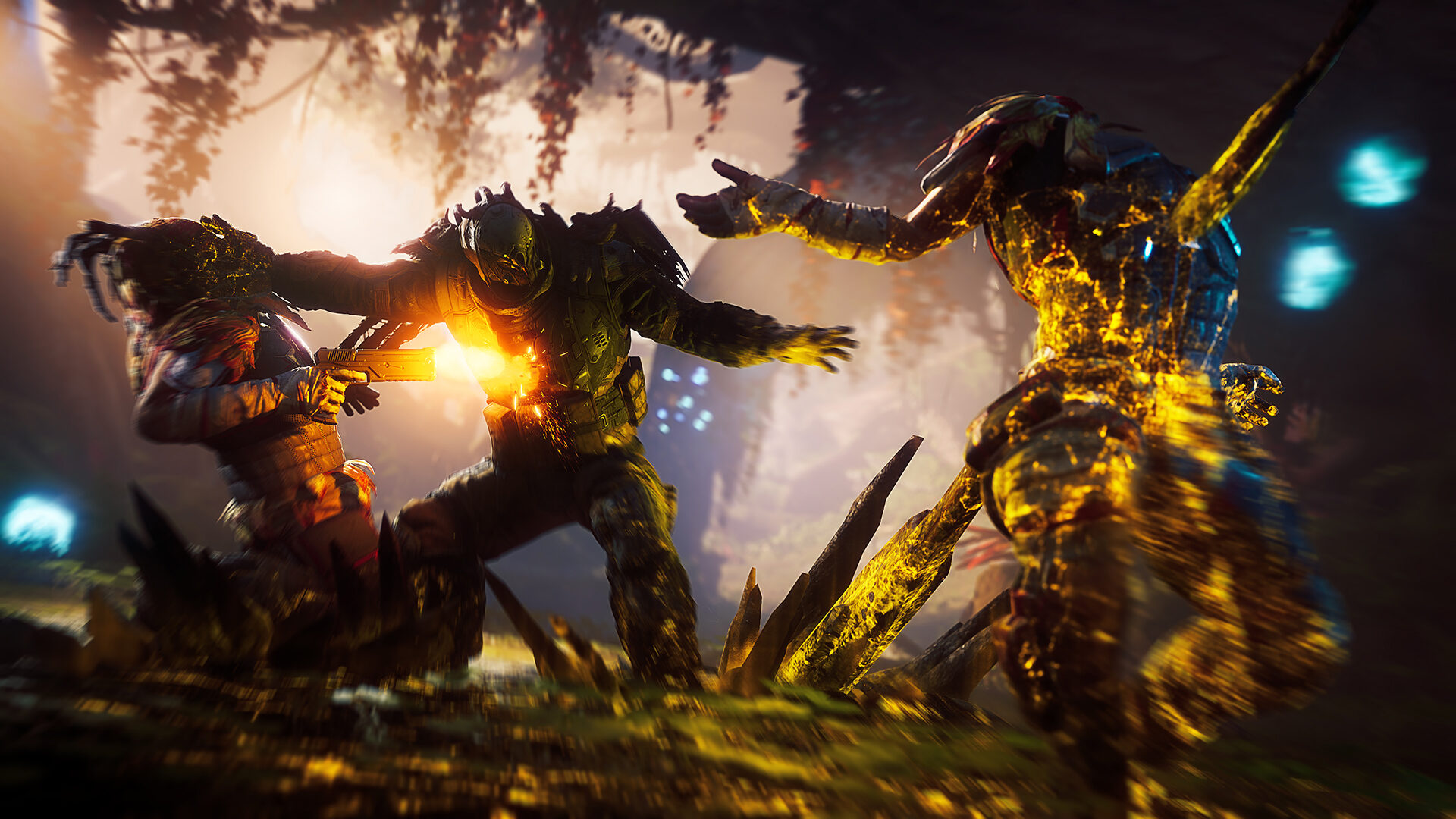Outriders is the game that People Can Fly creative director Bartek Kmita called “the game we always wanted to play.” In reality, it feels like many games that many people wanted to play, jam-packed into one experience. It’s a game practically bursting with ideas and discordant design decisions that is miraculous when it actually works and utterly, teeth-grindingly frustrating when its various systems bump up against one another.
Taking place in yet another dystopian future where human beings can’t get their collective act together, Outriders’ story starts with a group of space explorers waking up from an 80-year cryo-sleep and landing on a seemingly utopian, untouched planet called Enoch. Earth had become uninhabitable—thanks in part, no doubt, to the corporations that funded the exclusive, intergalactic trip to Enoch—so humanity needed another planet to colonize. However, the Earthlings on Enoch, including a group of mercenaries called Outriders, soon discover that their new home isn’t as utopian as they imagined when a terrifying electrical storm sweeps through their crews and starts zapping people into dust. Thankfully, there’s one colonist who doesn’t turn into dust when they’re zapped, and that’s your customized Outrider, who further sustains injuries in an explosion and is promptly put back into cryo-sleep. Yes, that’s right: There are two instances of cryo-sleep within the opening minutes of the game.
When your Outrider wakes up (again) 30 years later, they find an Enoch that’s been quickly torn asunder by a civil war between two factions of humanity. Even if you put a gun to my head, I couldn’t recall what those factions are called, but one is led by a former colleague of yours, while the other is made up of Mad Max–style psychopaths who like to string up their victims’ bodies like trophies. (Hmm, I wonder who you’re supposed to side with.) When your Outrider is captured by the latter, they are forced to run across a no man’s land, where an electrical storm like the one that killed your buddies three decades ago has formed. The storm sends a lead pipe through your chest, but the electrical storm—hereafter known as the “Anomaly”—that hit you before your second cryo-sleep gave you untold powers and turned you into an Altered. You rip the pipe out of your chest, kill a bunch of enemies with your newfound powers, and meet back up with your old crew—literally old, since they’ve all aged 30 years while you were taking an ice nap. Pretty soon, you agree to help them fight their war, and it’s off to the races.
It might seem unnecessary to go into such excruciating detail about the game’s story, but that’s just the thing: This is just the setup to Outriders’ story. While most games with this kind of plot setup would maybe use these foundations to explore the lightning-fast breakdown of a new society, or the existential nightmare of your friends all aging 30 years overnight, Outriders doesn’t spend nearly any time exploring these possibilities. Instead, it becomes an adventure story about the colonization of a planet, though you really only find that out in the final third of the game’s narrative.

I guess my point is that People Can Fly’s approach to Outriders’ story is the same as its approach to gameplay, which is taking every trope possible and mixing them all together in a way that’s both endearingly over-the-top and disregardful of any sense of consistency.
When Outriders is fun, it’s really fun. People Can Fly has taken elements from every game it’s ever worked on and combined them into one of the most satisfying third-person shooters in recent memory. It expands on Bulletstorm’s powers by giving you four different Altered classes to choose from—Trickster, Pyromancer, Devastator, and Technomancer—that all have their own supernatural abilities. Then it throws Painkiller-sized hordes of enemies at you. It lets you take a breather while hugging a wall using Gears of War–style cover mechanics. And it has followed a recent trend in shooters like the new Doom games and Remedy’s Control where you need to attack to heal yourself. The result is a bullet-filled tornado of blood and viscera the likes of which I’ve never seen in a video game, and it can be absolutely glorious under the right circumstances.
Part of what makes Outriders’ core action gameplay so successful is the fluidity of its movement. Compared to their first-person cousins, third-person shooters often feel clunkier or, if that’s too harsh a description, at least more measured in their approaches to character movement. I think that’s partly due to the fact that, in third-person shooters, you’re always seeing how your character is interacting with the world. Too much speed, and it would look like your character is defying the laws of physics. But the thing with Outriders is that it just doesn’t care. Yes, the lack of friction makes your character appear to be practically ice skating through the world, at least when they’re in the sprinting animation, but so what? It might look stupid, but running from cover to cover and blasting Enoch’s natural food chain into piles of chunky goop with a shotgun feels awesome.
Its other standout element is the Altered abilities and how they complement the gunplay. Every class has eight different abilities that you unlock as you level up your character, with three abilities equippable at any given time. On top of that, each class has a different way of regenerating health. The Technomancer, for example, heals every time they hit an enemy with a toxin attack from one of their abilities, while the Pyromancer heals whenever an enemy they’ve hit with one of their abilities is killed—by them or a teammate.
This health system works so well in Outriders because of how thoroughly it’s integrated into the design of each character class and how it creates problems that you must solve during a fight. Playing mostly as the Trickster, who manipulates time and space, I had to focus on close-quarters combat since, in order to refill my HP, I needed to kill enemies that were near me. That meant that, through the game’s roughly 25-hour campaign, shotguns were my best friend. Using the Trickster’s Hunt The Prey ability, which lets you teleport directly behind a targeted enemy, I could usually bring the small guys down in one or two hits. For the more “elite” enemies with bigger health bars, I would usually combine Hunt The Prey with Slow Trap, which creates a bubble that slows down everything—bullets and enemies—within it and then use a more offensive ability like Twisted Rounds or Venerator’s Knife before unloading on them with my shotgun or SMG.

Strategically stringing abilities together in a fast-paced gunfight is the heart of Outriders’ gameplay, and it’s exhilarating—when it works. No matter how powerful your character is or how smart you are with your movements, Outriders’ jank will show up to smack you across the face. There were so many times when I’d trigger Hunt The Prey and my character would go into the animation, only to get stuck on some piece of level geometry and end up sitting dumbly in the middle of an open field getting pelted with bullets. Or, on the brink of death, I would use Slow Trap to kill a bunch of swarming enemies, only to have my follow-up shots blocked by their torsos floating in slow motion after I exploded them with my shotgun, robbing me of that precious health regeneration that would have saved me from death. When playing on higher difficulty levels (which are called World Tiers, but more on that minute) where the margins of error are razor-thin, these kinds of seemingly insignificant bugs often resulted in a nearly immediate death, especially playing solo, sending me all the way back to the beginning of an area. There is nothing more frustrating than clearing out dozens of enemies in a fight, only to have the game fail you in your most vulnerable moment and leave you a broken, bloodied corpse.
These issues become even more prominent when going it alone against tough bosses. While most bosses will send you a bunch of smaller enemies to kill so that you can regenerate health, some bosses don’t give a single way to earn health back. There were two bosses in particular that I had to turn down the difficulty setting to beat because there was simply no way I could win otherwise. The final boss of the game, in particular, basically made me choose between going all the way down to the lowest difficulty or throwing my controller through my TV. I chose the first option. Talk about anticlimactic.
Most of these issues might be specific to the Trickster class, but that doesn’t make them any less frustrating. However, it isn’t just that these snafus happen, but it’s the way that Outriders’ inconsistent RPG mechanics can compound them to create a unique brand of fist-clenching, cuss-spewing agony.
To be clear, most of the ideas behind the “role-playing” stuff in Outsiders are great. The different mods that you can equip to your weapons and armor have a significant impact on how you will want to kit out and play as your class. A lot of the mods will buff your abilities, while others will add bonuses to your guns, ranging from the obvious like extra burn or toxic damage to your shots, to the more useful and life-saving, like getting health for every enemy you kill between weapon reloads. Mixing and matching these combinations and finding the best one for your preferred playstyle might sound like busywork, but the effects these mods have are so pronounced and obvious that it’s actually fun to experiment with them. The skill tree, while pretty much the kind of standard-looking series of branching nodes that you’d expect any old action RPG nowadays to have, still gives you some really interesting choices that feel consequential since skill points are pretty scarce.
But where Outriders’ RPG mechanics really get in the game’s way is with its leveling system and its World Tier dynamic difficulty settings. In theory, the dynamic system isn’t a bad idea. The World Tier you’re playing on will determine how much higher your enemies’ levels are compared to your own. Playing on World Tier 8—”Immortal” difficulty—will put you up against enemies that are five levels higher than you, but it will also mean that the loot they drop will also be five levels higher than your current level. Drop rates for higher rarity items and legendary mods are also significantly higher. In order to reach higher World Tiers, you need to fill up your World Tier meter, and in order to do that, you need to kill a bunch of enemies without dying. If you die, you lose some meter and will have to earn it back.
When this system works, it’s great. Dead enemies will shower you in Epic and Legendary gear, which have multiple mod slots and really let you go nuts with customizing your character’s loadout. When it doesn’t work, however, it makes you feel utterly hopeless.
Part of the problem is with the loot system. I don’t know how Outriders determines the gear you get, but half the time it felt completely random and pointless. Not only do weapons have their own levels, for example, but they also have about a million other numbers that determine their worth and utility, including the obvious ones like damage and rate of fire, and not so obvious ratings like “firepower.” Often, I would be playing on a new World Tier and get utterly stomped for, like, an hour straight. The enemies that I managed to kill would drop new items or weapons, but sometimes they would be worse than the stuff I had gotten in a previous World Tier. Then, totally randomly, I would get a weapon that had double the firepower rating of a previous weapon. Then I would go back to getting stuff that was worse. And when I did get a new weapon, very rarely was it the kind of shotgun I needed to fully take advantage of my Trickster’s strength in close-quarter combat. Or I would get a bunch of better weapons but no new armor, so I could maybe kill more enemies, but I would still die almost instantaneously. Of course, you always have the option to lower the World Tier, but if you then want to increase the difficulty again to get better loot, you’ll still just be stuck with a bunch of lower-level gear.
What’s baffling about the World Tier system is that it can halt what is an otherwise engaging sense of progress while feeling completely unnecessary. In fact, most of the number-based RPG stuff feels totally pointless. Why, in what is mostly a straightforward action game with a handful of side activities and a clearly defined endpoint, do I need to worry about having the right level of gear? What does that actually add to the game besides a false sense of progression, especially considering that the mostly linear nature of the game’s story and experience already has that sense of progression built into its very foundation? Instead of using loot and numbers to make players want to complete side activities, why not have weapon and armor mods—the stuff that’s actually fun to experiment with and earn—be the goals?
There are some smaller complaints I could harp on—the unreliable cover mechanics that I barely used, the weird bugs that would sometimes make the game’s waypoint system direct me into a literal dead end—but it’s the uneven application of the game’s World Tiers and leveling system that prevent Outriders from being the truly standout title that it could have been. While it may not be the absolute disaster that another superpowered, Square Enix–published action RPG ended up being, it isn’t the total rip-roaring adventure that it deserved to be.
Outriders is a blast, until it isn’t. And when it isn’t, it feels like the end of the world.

Images: Square Enix
|
★★★☆☆
People Can Fly’s special brand of explosive gunplay is better than ever in Outriders, but the game loses its way by shoehorning in too many of the RPG mechanics that have become bog standard for the “looter shooter” genre. What should have been a rollercoaster all the way through ends up feeling more like a car in stop-and-go traffic. |
Developer People Can Fly Publisher Square Enix ESRB M - Mature Release Date 04.01.21 |
| Outriders is available on Xbox Series X/S, PlayStation 5, Xbox One, PlayStation 4, and PC. Primary version played was for Xbox Series X. Product was provided by Square Enix for the benefit of this coverage. EGM reviews on a scale of one to five stars. | |

Michael Goroff has written and edited for EGM since 2017. You can follow him on Twitter @gogogoroff.